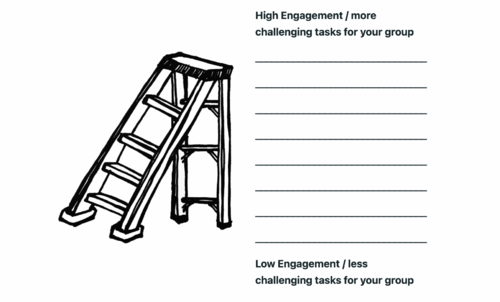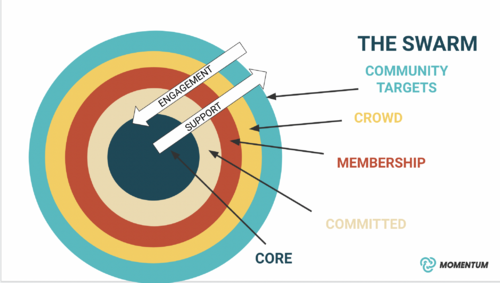Mobilizing and activating members: recruitment and retention 101
Grassroots groups often struggle with the challenge of mobilizing new members. Many also face challenges with retention, that is, members burn out and/or stop participating. Challenges to membership can make momentum building difficult, and may result in a reduced motivation of existing group members. Challenges to recruitment and retention can, in many cases, be mitigated and navigated by including some key structures and strategies in grassroots organizing spaces.
The following resource was compiled using existing organizer databases and resources by movement thinkers on mobilizing new members, and using thoughts from grassroots organizers who attended our learning circle on mobilizing new members. This guide was developed in response to request from grassroots groups asking for tips on growing their membership, that is, on effective recruitment and retention strategies.
Highlighted text is knowledge shared during our Learning Circle on this topic.
Beginning the planning process [1]
Before you begin building or defining your recruitment and retention plan, reflect as a team on the following:
• Why are we here, and how did we get here?
Participants in the HUB's learning circle responded with the following upon reflection...
| To connect with others who care |
A desire for shared spaces, connection and collectivity. To be in the company of like-minded people who want to act on the climate crisis. Coming from Alberta where it's scary to be a climate activist, I want to be surrounded by those who feel the same way to feel less alone.
To find those with the same worldview, shared concerns and a commitment to fighting for change to build solutions. |
| To combat climate grief and anxiety |
I want to feel less alone with feelings of climate grief and anxiety. I feel compelled to direct climate anxiety into action. I'm searching for solidarity and hope amidst climate chaos. To combat fear, grief and disillusionment with the lack of political will and action. I'm deeply concerned about climate impacts. I want a better future for my grandchildren. |
| To take action |
Because of my personal responsibility, passion and agency. To use each of our skills and potential to do our part. I want to advance; to learn, unlearn, and co-create the systems change needed to move us towards a just future. I have the desire to create something from the ground up rather than just being involved in a campaign that tells you what to do. For hope, power and optimism through collective action. Localized changemaking helps make wins feel more tangible. To hold those in power accountable. |
• Who used to be around and why did they leave?
'
• What keeps people sticking around?
Models to help guide recruitment and retention strategies
Each stage, depending on where folks fall in the following models, requires a targeted set of strategies.
Ladder of engagement [2]
The ladder of engagement can be a helpful tool for describing calls to action folks who are not involved in your group can take to become engaged, whilst also considering how people can increase their engagement towards becoming more active members. Someone who is a “1,” or at the bottom of the ladder in the model has no connection to your campaign or issue, and a “5” is someone who is ready to show up at an action.
Actions on the ladder escalate in intensity and/or demand or requirements of the individual as they move up and become more active. Consider what people might need to feel confident in moving up the ladder, and how you can support.
Of course, the ladder should serve as an outline only. Some people might be more willing to participate in an action that make phone calls. The idea, however, is to paint a picture of which actions have the fewest barriers to entry, that can encourage folks to get more involved as active members.

Image by: 350.org
Circles of commitment [3]
The circles of commitment helps to model the involvement of people engaging with or in your group, by acting as an outline for you plan to move people from the outer circles (low commitment) to the inner circles (high commitment).

Diagram from: Momentum Training Community
Levels of the circles of commitment
| Community targets |
Audiences you try to reach out to and engage; those not yet involved with your group in any capacity. See the section on community mapping for more on defining your targets. |
|
Crowd |
Your mailing list and/or social media following. |
| Membership |
Those who regularly participate; e.g. those who respond to calls to action. |
| Committed |
High action takers and people who would consider themselves formal 'members' of a group. |
| Core | Steers a lot of the group's direction; typically includes those who have been in the group the longest, or who have the most lived and/or organizing experience. (In smaller teams, the committed and core may be combined). |
Engaging community members to join your base
The following describes strategies for moving people from community targets to the crowd/membership levels of the circles of commitment model.
Defining community targets using community mapping [4]
A helpful first step for moving community targets is to define who they are! Who are you trying to reach?
Community mapping aims to gather information about how a community operates to develop the right strategies to mobilize and involve them. Rather than taking a broad approach to recruitment, this longer-term process of listening develops more targeted messaging and approaches, and builds foundations of relationships that are more likely to lead to involvement.
Community mapping can help you identify:
- organizing opportunities
- campaign partners and opportunities for solidarity
- potential threats
- the political climate
This information can support you when developing outreach plans, as well as when building coalitions and deciding on messaging.
Steps of community mapping [5]
| 1. Define a community |
This might include a community...
Questions to ask that can help you define a community to work with include...
|
|
|
Invite a few members of the community to engage in some discussion. For example, if you want to engage teachers in your community, can you think of a couple teachers who would be willing enough to chat over coffee? Make this as inviting as possible, and ensure it meets their needs! (e.g. is online or over lunch best?)
Questions to ask during these meetings include...
|
| 3. Document and carry out the plan outlined through discussion with community members |
|
Choosing engagement strategies
Strategies used to mobilize community targets tend to fall on the lower end of the ladder of engagement (meaning engagement isn't a huge commitment). For example:
|
Social media |
|
|
Passing by actions |
|
|
Local news coverage |
|
|
Postering |
|
|
Direct, one-on-one recruitment conversations |
(See the below section for more details) |
The following strategies were suggested from participants in our navigating turnover in student groups learning circle:
|
Take over space! |
|
|
Take your time |
|
|
Outdoor gathering spaces |
|
If you're a university-based group, check out this resource by Divest Ed for more strategies!
One-on-one recruitment [6]
Canvassing means "talking to someone on the street, inviting them into your shared purpose or campaign goal and trying to get their signature and contact information." -The Future Ground Network. Stay tuned for more from our 'deep canvassing' offering. In the meantime, you can learn more about how to engage with people directly to join your group through this resource.
Your recruitment pitch
A recruitment pitch, which shouldn't be longer than about 30 seconds, should include [7] :
| a) An explanation of the purpose of your team in general. |
|
|
b) An explanation of why you chose to be a part of the team and why you care about the issue. |
|
| c) Your hard ask |
|
Responding to 'no' [8]
Your response will depend on the type of no communicated.
| Not now |
|
|
Not that |
|
| Not ever |
|
Engaging your base to increase involvement
The following describes strategies for moving people from the crowd into membership/committed circles of the circles of commitment model.
Strategies used to activate current members of your crowd should fall primarily on the mid to upper end of the ladder of engagement. For example:
|
Attending meet ups and information events |
|
|
Opportunities for providing support |
|
|
Opportunities for spreading the word |
|
|
Direct, one-on-one recruitment conversations |
(See the above section for more details) |
The following was suggested from participants in our navigating turnover in student groups learning circle:
In some schools, a bootcamp (3 day online intensive) to get people up to speed on information, and bring the information to new people, is helpful. The important thing is to keep the relationships.
How to welcome new members
Have a welcome plan prepared for new joiners to welcome them and provide the information they need about the group they're joining! This might look like a welcome presentation or meeting to review key documents and inner workings, for example.
A simple structure for a welcome meeting is as follows [9] :
| Scheduled in advance |
20-40 minutes in length. |
| Between as few people as possible |
To gain personal connections |
|
A loose agenda could look like... |
|
The following was suggested from participants in our navigating turnover in student groups learning circle:
- Divest McGill made a document to inform incoming members of who the board of directors (the targets) for their campaign were, complete with their names, photos and info on each. This helps new members plug in.
For more on welcoming new members see this resource by Beautiful Trouble.
Retention suggestions
|
Take action! |
|
|
Don't neglect the value of joy and connection |
|
|
Ask people for their accessibility needs |
|
|
Include various forms of participation and meet people where they're at |
|
|
Articulate purpose often
|
|
|
Plan for breaks |
|
Summary
The engagement paradox (from a study done on the organizers and volunteers involved in Barack Obama’s Get Out the Vote campaign) works under the assumptions that [10] :
- You SHOW UP because somebody asked.
- You COMMIT because of the relationships.
- You WALK AWAY when you don’t feel effective
If you have any suggested revisions or additional resources to share related to the above content, please email them to kenzie@lehub.ca.

- ↑ https://futuregroundnetwork.org/resource/how-to-recruit-new-members/?wpdmdl=1502&refresh=639b7f5ed5b1b1671135070
- ↑ https://trainings.350.org/resource/increase-your-volunteers-involvement/
- ↑ https://www.momentumcommunity.org/
- ↑ https://commonslibrary.org/community-mapping/
- ↑ https://commonslibrary.org/community-mapping/
- ↑ https://futuregroundnetwork.org/resource/how-to-recruit-new-members/?wpdmdl=1502&refresh=639b7f5ed5b1b1671135070
- ↑ http://marshallganz.usmblogs.com/files/2012/08/Public-Narrative-Worksheet-Fall-2013-.pdf
- ↑ https://futuregroundnetwork.org/resource/how-to-recruit-new-members/?wpdmdl=1502&refresh=639b7f5ed5b1b1671135070
- ↑ https://futuregroundnetwork.org/resource/how-to-recruit-new-members/?wpdmdl=1502&refresh=639b7f5ed5b1b1671135070
- ↑ https://futuregroundnetwork.org/resource/how-to-recruit-new-members/?wpdmdl=1502&refresh=639b7f5ed5b1b1671135070